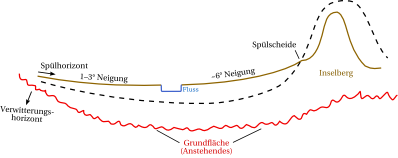Rinsing surface
In geomorphology, a flushing area is a denudative shape of the landscape that is mostly found in tropical and subtropical climates. In polders can inselbergs be found.
The term was coined by Julius Büdel and later replaced by a sink surface . According to Büdel, rinsing surfaces are "slightly inclined planar forms of removal of an active subtropical trunk area in contrast to the valley". Herbert Louis contradicts the distinction between rinsing area and valley , as both are formed by the same basic mechanism.
Emergence
Even the intensive weathering of the tropics (the carbonic acid content in the soil air is up to 20%, i.e. 20-40 times the value of the middle widths) alone cannot contribute to erosion and thus to form formation. The thickness of the tropical soils that it reaches proves this (thicknesses of at least 3 m everywhere, but often twice as much - 6 m - and under certain circumstances can reach ten times - 30 m). Up to slopes of approx. 8-10 ° the floors remain completely at rest and show no movement following the slope. What is already being removed in the soil itself and at its base are only substances that have gone into solution and carried away with the groundwater.
The mechanical work of continuing undissolved material takes place solely through the rinsing of clay and fine sand on the surface (or the washing horizon) of the floor during the rainy season. Two things are required for its effectiveness:
On the one hand, that the surface of the soil provides the chemically converted material in such a fineness that even a small rainy trickle can seize it and carry it away. In addition, the activity of many soil animals ( bioturbation ) always brings particularly fine material to the surface. The second prerequisite for extensive rinsing is the extensive destruction of the ground vegetation in the dry season. It starts in mid-September until the turn of October. After three and a half months with practically no rain, the grass and herb vegetation is usually completely dry by mid-February. Moving herds of herbivores ( gazelles , zebras , ...) or savanna fires often destroy the last remains of the ground vegetation.
As a result, the ground is defenseless at the beginning of the rainy season, which usually begins at the beginning of May. The soil in the puddles is already flooded with the first downpour, i.e. H. its particles go into suspension in water . However, this suspension alone does not cause any removal. This only happens when a film of water seeping from one puddle to the other has formed on the surface of the sink. Because at the same time a strong infiltration sets in with the first rainfall . On the other hand, however, the molecular force emanating from every swellable soil particle strongly holds the water once it has penetrated. The consequence is that even at the moment when only the top 1-2 m of the soil profile is saturated with water, further drainage of seepage water into the depth takes place only very slowly. This means that the bulk of the rainwater is then available for surface runoff or erosion.
literature
- Julius Büdel (1977): Climate Geomorphology. Brothers Borntraeger Verlag. Berlin, Stuttgart, ISBN 3-443-01017-2 .
- Julius Büdel (1986): Studies on tropical relief formation. In: Relief, Soil, Paleoclimate. Volume 4. Gebrüder Borntraeger Verlag. Berlin, Stuttgart, ISBN 3-443-09004-4 .
Footnotes
- ^ Flushing surface , Lexicon of Geography, In: Spektrum.de. Accessed January 2020.
